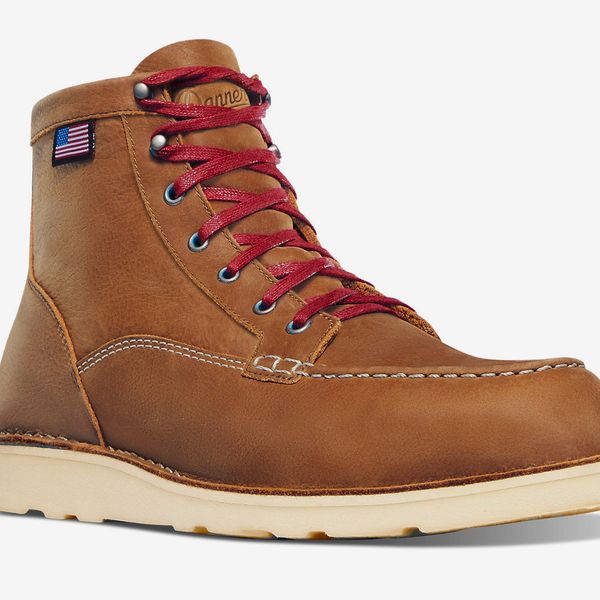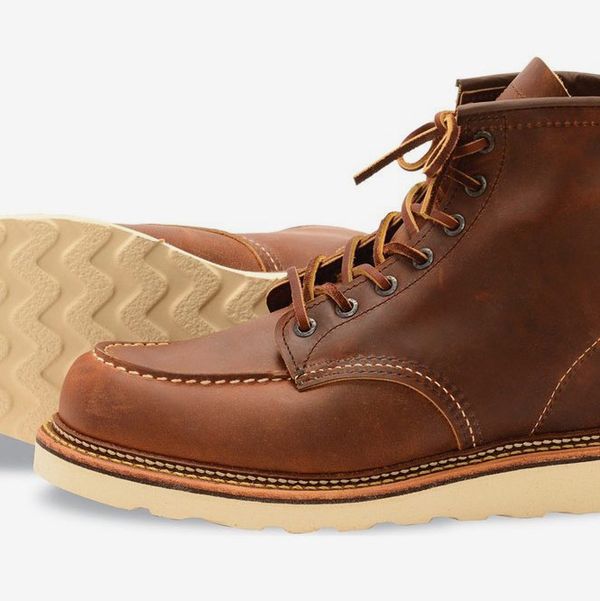
While it’s certainly been nice this summer to walk, hike, and (if you’re lucky enough to have one) garden in Birkenstocks and Tevas, September’s arrival means that soon enough we’ll be contending with rain, cold, snow, and slush as we go about our (outdoor) business.
Enter, the work boot — a menswear staple that’s as functional for intensive DIY projects as it is great-looking dressed up with a pair of jeans. As with any staple, however, for every painstakingly constructed and comfortable classic, there are even more companies making poor imitations. To find out which works boots will hold up through even the bitterest of winters, we called up eight craftsmen with exacting taste (and a couple of boot salesmen) to put together a range of options for every budget, whether you’re looking for a steel-toe pair to build your work-from-home shed or just a rugged leather option that’ll take you comfortably back and forth from the bodega in a downpour.
Below, 15 pairs, organized by price range and recommended by those who’ve worn them for years, from a gardener to a leatherworker to a literary agent who moonlights as a carpenter.
Best under-$200 work boots for men
Eugene Ferreira, a salesman at Brown’s Army and Navy in Jackson Heights who sells primarily to construction workers, told us that for work boots under $75, the only brand he trusts enough to stock in his store (which has been around since 1976) is Zanco. “The level of comfort is decent, as is the glue they use and the material to make the sole,” he says. “For a guy that’s starting a construction job and doesn’t want to spend too much money, they’ll do the job.”
For a pair of steel toe work boots that come in under $100, Ferreira recommends these from Caterpillar, which are waterproof and have a slip-resistant soles for rainy days.
Ron Finley, a celebrated gardener who teaches his own class on MasterClass, told us that these Bean boots are his “go-to. They’re comfortable, waterproof, made in the U.S., and look good.” Finley says he’s approaching two years of owning and wearing the same pair and that they’ve held up and are particularly great “when things get muddy — you never have to worry about your socks getting wet.”
Ferreira tells us that often, guys who impulse buy a classic, wheat-colored Timberland boot come into his store a few months later and complain about back pain. “That classic sole is not for every foot, because it’s not that shock-absorbent, no matter how many insoles you use.” That, he says, is where “anti-fatigue soles,” come in, which are designed “to put less stress on your back, knees, and feet.” These anti-fatigue boots may cost a little more, but he says they “outlast the cheaper ones. If you’re buying a pair of $50 work boots every five to eight months, you’ll spend more money in the long run than one $150 purchase which could last years.”
Adam Levy, the co-owner of renowned workwear retailer Dave’s New York (a store that’s recently become something of a streetwear mecca, too) told us about these lightweight, comfortable sneaker-style boots, which also have an anti-fatigue sole. “They’re superlight,” he says, “and have comfortable, cushioned Aerocore midsoles. And even though they’re very flexible, they have a composite toe that meets safety standards on a worksite.”
When we spoke to Brian Davis, the owner of vintage menswear emporium Wooden Sleepers, about his favorite work boots two years ago, he told us these Chippewas were his preferred pair. Though the Service Boot has a cleaner, slimmer shape than your average work boot, he says they’re still incredibly sturdy. “You can beat the hell out of them,” he said, “and they just get better and better.” At that time, Davis had already owned his pair “for years.” When we checked back in with him this month, now four years into ownership, he told us he’s “still kicking around in my Chippewas.”
Red Wing boots have been in production since 1905, and in the more than a century since they went into production the brand has become iconic both for the quality of its construction and the fact it still manufactures in the United States. While Red Wing boots, as you’ll see below, typically cost more than $200 (though many own theirs their entire lives), Levy tells us that their 405 shoe, which is fully waterproof, is a good option for someone who wants comfort and the workwear look but cares less about steel toes and other advanced safety features.
Best under-$300 work boots for men
From Red Wing to Danner to Thorogood, we found that the sweet spot for work boots that are as stylish as they are functional (and won’t ever need to be replaced, just repaired) lies in the just-under-$300 range. James Lynch, a Strategist contributor and outdoorsman, wears these Danner boots while woodworking and says they can function equally well as a dress boot and a work boot. On the practical side, Lynch says their “OrthoLite footbed keeps you comfy and locked in, and the wedge sole is soft on hard surfaces and slip-resistant.” And in terms of aesthetics, Lynch says their “brass eyelets have an awesome baby-blue patina that contrasts beautifully with the trademark red Danner laces, the nubuck leather is soft, comfortable, and gorgeous, and the little American flag stitched into the side lets you know they’re made in America.” In sum, he says, it’s “the work boot that does it all.”
General Contractor Ethan Sale, of ES Builds, told us he’s worn different versions of these Thorogood boots “for 10 years,” and while he replaces them every two years due to the intensity of his work, he says a “normal” person likely wouldn’t ever have to. “They’re comfortable and fade beautifully,” he says. (His partner noted that another reason he wears them is that they are the same boots that famous American framer Larry Haun wore.)
Designer and educator Tom Bonamici told us that he “wore classic work boots like Danners and Thorogoods for years but got tired of their weight and bulk, especially because I also use my work boots for hiking, hunting, and motorcycling.” The solution, he discovered, was a futuristic pair of boots from running brand Hoka One One. “I love them. They’re superlight, sneaker-comfortable, and cushioned enough to stand around on a concrete shop floor all day without a problem.”
While Red Wing is best known for its 875 boots, which we’ve called a “category definer” in the past, Levy (who knows the 875s well) told us that he views the brand’s 1907 style, which costs the same, as a slight improvement. “It’s similar, with a few differences,” he says. “It has a Norwegian double welt, which means the shoe and outsole are stitched in different variations, giving you extra durability throughout. The stiffer sole is not as foamy and spongy, and the leather insole has more comfort than the inner of the 875.” Plus, he says, it comes with leather laces, which have two benefits. “A more rustic feel, and if you’re welding or using sparks, leather laces won’t melt or burn like nylon ones.”
For a slightly less rugged look that still has all the long-lasting quality of Red Wing boot, Levy recommends the brand’s Heritage Blacksmith model. “It has a clean toe, which elevates it without making it dressy, and it comes in a dyed brown leather that looks like a slightly more-relaxed black” that would look as good with jeans at a restaurant as they would working around the house.
Best splurge-worthy work boots for men
Odin Clack, of Texas’s Odin Leather Goods, told us that even as someone who works in a tannery all day, he’s only needed “three pairs of these Red Wing Peco Boots over the last 22 years” and says he “still can’t get enough of them. They’re my go-to, everyday boot. They’re suitable to wear all day long and year-round — in the heat, rain, snow, and can be dressed up or down.” At most, they need “a little brushing to knock the dirt off and a little oil now and then,” but Clack says that’s really up to the wearer. While the Pecos are so popular that they’re hard to find in stock, this model, which is currently available, is one of the three Clack owns and loves.
Chris Fenimore, a street-style photographer in New York City who captures the best men’s fits across Lower Manhattan, come rain or shine, tells us these boots are “superb” and that “the company’s founders took great care to make waterproof boots that look good and are highly functional. They’re very comfortable and built to handle any sort of use.” When it comes to sizing, Fenimore recommends going a half size down (the company says to as well). What’s more, he adds, “it’s just a good time to support a small business.”
Another independent brand worth supporting came recommended to us by Edward Orloff, who is, as the New York Times put it last year, a “book agent in the morning, carpenter in the afternoon.” (He’s made shelves through his company Rift Cabinetry for everyone from Emma Straub to Hamilton biographer Ron Chernow). Orloff told us he’s a “fan of everything from Oak Street Bootmakers, but specifically these ones.” The Camp Boots have a nonslip sole, are fully made in the U.S.A., and are “100% recraftable,” meaning every part of the entire shoe can be repaired again and again.
The Strategist is designed to surface the most useful, expert recommendations for things to buy across the vast e-commerce landscape. Some of our latest conquests include the best acne treatments, rolling luggage, pillows for side sleepers, natural anxiety remedies, and bath towels. We update links when possible, but note that deals can expire and all prices are subject to change.
Every editorial product is independently selected. If you buy something through our links, New York may earn an affiliate commission.





















